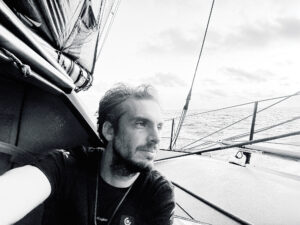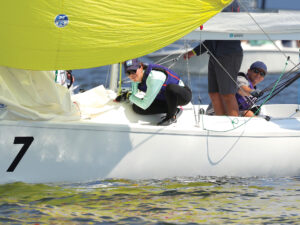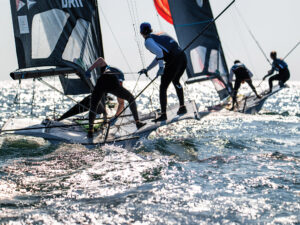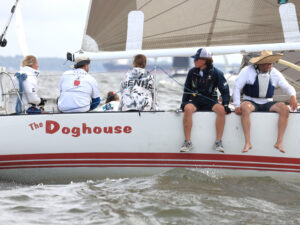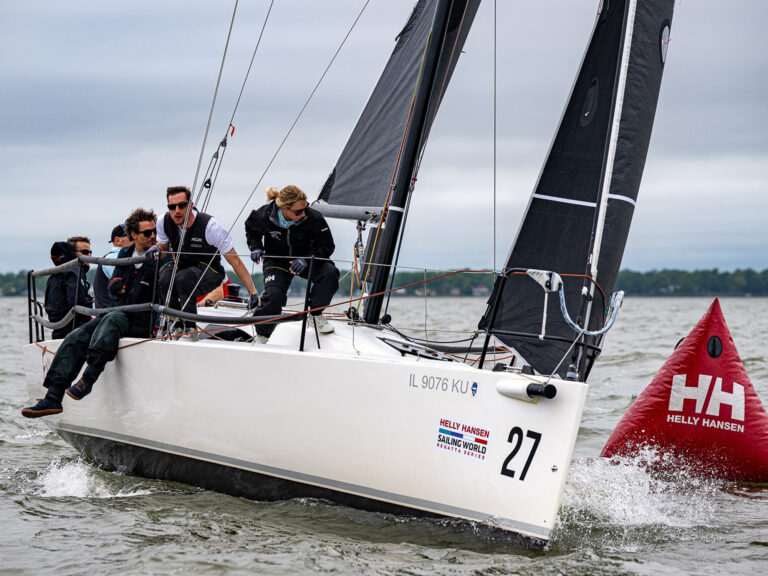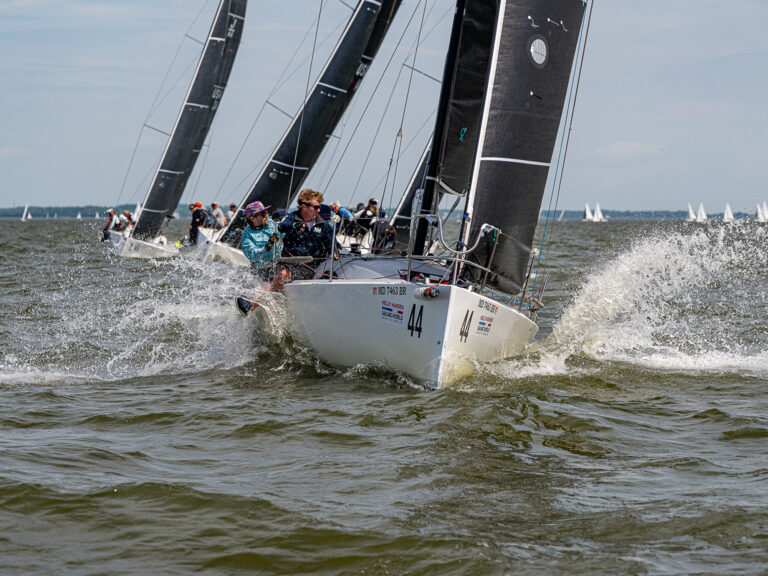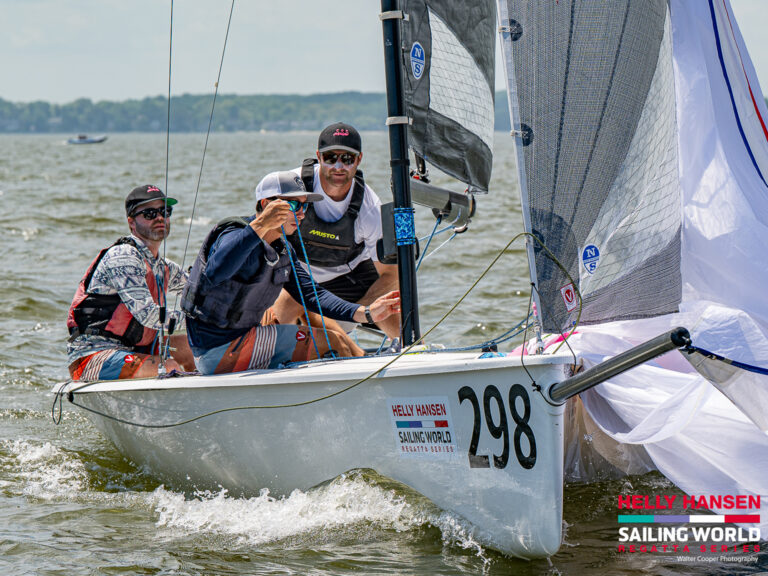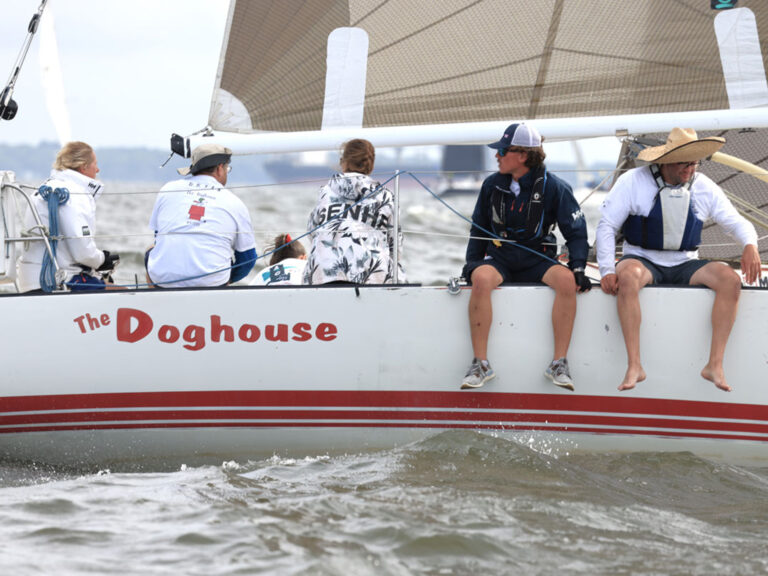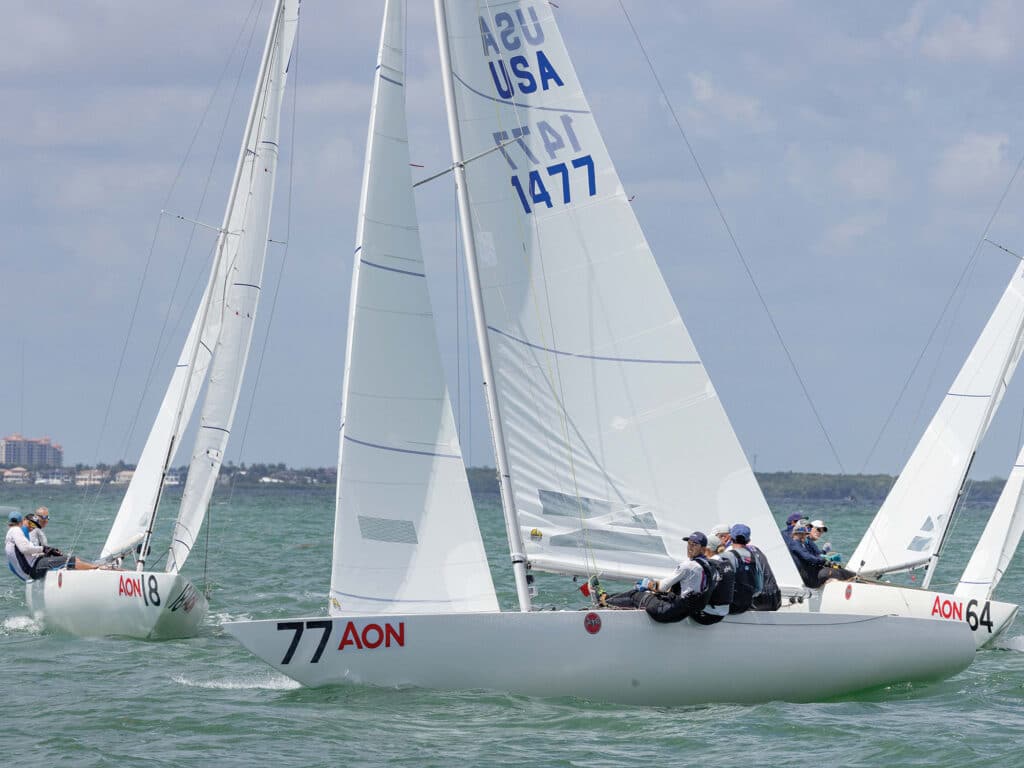
Victor Diaz de Leon often rides his road bike for a couple of hours before and after a day of racing. In the saddle, he doesn’t listen to music. Instead, he’s simulating racecourse scenarios: what was happening on the boat, what the tactical play would be or could have been. “It’s a time of meditation; a place where I get ideas,” says the Etchells world champion tactician, who calculated a brilliant final-race win in Miami in April, a race executed alongside his teammates on John Sommi’s Veracity.
To earn the title on that light and shifty last day of the Aon Etchells World Championship, Veracity had to beat series leader and past world champ Steve Benjamin and his all-star crew on Tons of Steel, but there was a lot to it. Hedging a one-race day, Diaz de Leon hatched a plan: “I knew it would be hard to make nine points on Benji with only one race, especially if they had a good race themselves. So, I’m thinking we just have to have a good start, assess where others are in the race and take it from there.”
The others were Jim Cunningham’s Lifted, tied with Veracity, and Luke Lawrence’s Cruel Jane 2.0, sitting mere points behind in third.
“We started near the favored pin end in a tight lane, but held on long enough that when we tacked to port, we were strong on the fleet. When we tacked, Benji was a few lengths below us, slightly bow forward, and it turned into a real speed thing to get strong on him and get ahead of him. When we finally recognized Jim and Luke’s teams were deep, it was us and Benji, and it was on.”
Problem was they were 1-2 at that moment and both were “launched.” “If we won and they got second, that wouldn’t work,” Diaz de Leon says, “so we decided to start playing down on them.”
Veracity slowed its rival as much as they could on the starboard layline, allowing a few boats to get ahead and between them. Veracity was fourth to the mark and Steel was ninth. Still not enough.
“Playing backward downwind is very risky,” Diaz de Leon says, “because it’s easy to get passed. So, I was comfortable just doing it all upwind.”
On the second beat, Veracity herded Steel deeper into the fleet, always from a controlling position. “It was important to do it as early as we could,” Diaz de Leon says. “We were conscious about not getting too close or ever slower than them, but there was less tacking than I anticipated. They were content sailing in our bad air, which made it a bit easier. They were also reaching a lot to try to get clear air, and I was happy with that too as we were sailing into the fleet. The magic number for us was they had to finish 22nd or worse.”
A jibing duel down the next run continued the skirmish, pushing Steel ever deeper to beat them around the course with points to spare. They celebrated their win with Champagne and plunges, but once ashore there was the business of two protests lodged by Benjamin’s tactician Mike Buckley, who invoked rules 11 and 17. To the protest room Veracity dispatched its trimmer, Will Ryan, a two-time Olympic medalist and national judge. The situation involved an attempted luff on a windward leg, and the way the veteran judges saw it, Benjamin overstuffed his luff and was ultimately disqualified.
Veracity’s owner and skipper, 65-year-old John Sommi, from Darien, Connecticut, got his first sailing world title, and as is always the case, this win was a high-caliber team effort. On the bow was Beccy Anderson, who is also Veracity’s boat captain. It was Anderson who deftly identified Lifted and Cruel Jane in the lineup of identical boats and white sails during that last race, empowering Diaz de Leon to promptly execute Plan A.
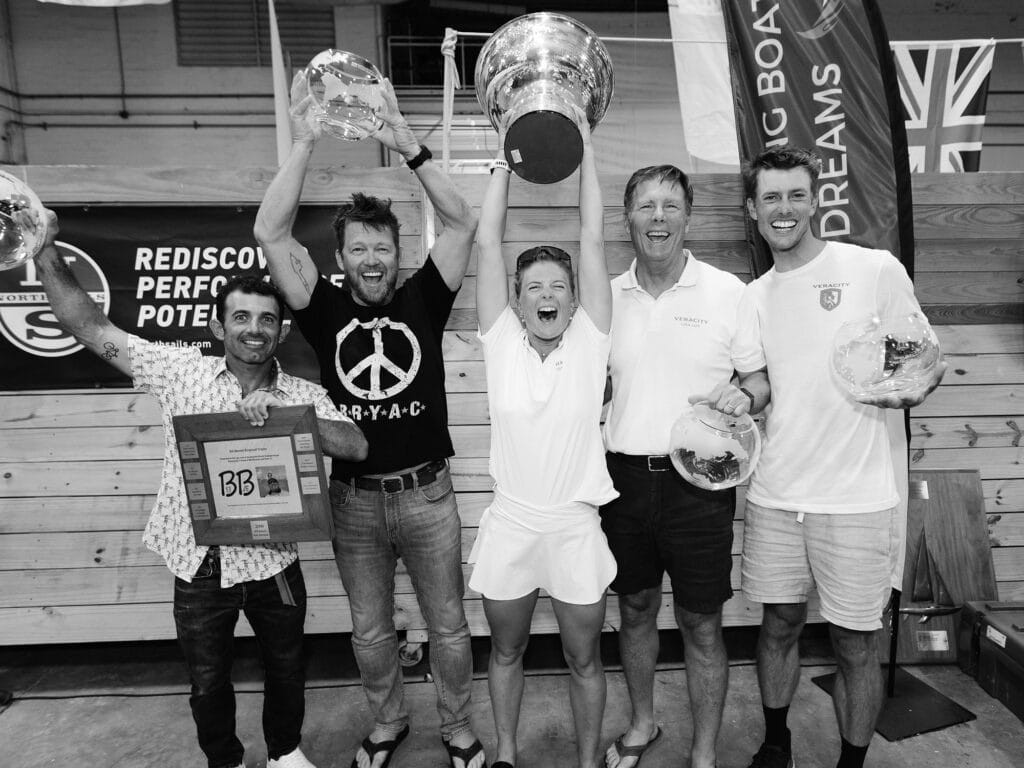
Ryan, who won his Olympic 470 gold medal in Tokyo and his silver in Rio, is the team’s speed maestro, and Sommi is, of course, on the helm. They’d been sailing for more than a year, a syndicate that formed when Sommi, a successful Wall Street executive and father of four young adults, found himself with an empty nest and a desire to get back to sailing. Sommi campaigned a J/88 and a Melges 20 before diving into the deep end of the high-stakes Etchells class. “The goal was to go sailing and play at a high level,” says Diaz de Leon, “and I remember John saying that he just wanted to sail well and be respected—or something like that.”
They won both the National and North American championships last year. “We were sailing really well,” Diaz de Leon says. “And then one day, Will said, ‘Someone has to win the Worlds, so why couldn’t it be us?’”
With a supporting cast of top-shelf coaches that included Veracity teammate Tom Dietrich, sailmaker Chris Larson, Etchells whisperer Jud Smith and pro-sailing legend Morgan Trubovich, Veracity established itself as the team to beat by winning the first of three Miami Winter Series events that were each essentially pre-Worlds regattas. As a result of a collision before the second event, Veracity’s mast was toast, and that’s a big deal in Etchells sailing because rig tune on this tweakable old one-design is everything.
“All the tuning numbers and the characteristics of the rig that suited our style were gone, and the next rig we got didn’t suit our style,” Diaz de Leon says. “That was difficult, and we did the second event with the new mast and we struggled.”
They then dispatched Larson to the Selden Mast factory in Charleston, South Carolina, on a forensic search for the perfect spar. Larson bend-tested several spars and picked the best two he could find. “We weren’t as fast as we were [with the old mast] initially, but we got better and better,” Diaz de Leon says.
Veracity’s results at the Miami Worlds speak for themselves, from the development of their sails with Smith to their many tuning and training sessions of the past year. They were never slow and, aside from the match-race discard with Steel, 12th was their highest finish over eight races in the fleet of 65. A review of Veracity’s tracker replays paints a picture of their consistent approach to the congested Biscayne Bay racecourse. They never once started at an end, they worked the middle left on the first beat, middle right on the second, and worked the center of the course on every downwind leg, which is easier to accomplish with good starts.
“Most of the time when I start a race, I don’t know where I want to go,” Diaz de Leon admits. “I like to leave my options open and decipher during the race. By starting toward the middle [of the line], there’s lower density, and it’s harder for the race committee to call the boats there. Working with Truby (Trubovich) in our debriefs, we got a sense of the race committee’s style during the general recalls. The race committee [on the signal boat] was more aggressive calling boats than the pin boat, so I figured I might as well move a bit left.”
They were also geared up for every start, and Diaz de Leon says that was all thanks to Trubovich, who deployed his own buoys in the starting area in the morning, which Veracity would use for three practice starts as part of their pre-race routine. Trubovich, a 16-time world champion from New Zealand who has enjoyed a fruitful career in the grand-prix world, is also representative of the level of coaching in the Etchells class today that makes winning impossible for mere mortals. He brings all the tools to the table, as well as an attention to technical detail and a sense of humor that Diaz de Leon says was magic to the team.
“He just brings such a great positive energy, and his debriefs are incredible with the technology. Let me give you an example: For the Worlds, he sent me out to Best Buy to get a bigger TV for the hotel room because the one we had was too small. He told me the model we needed, and I came back with this huge cinema TV, and it really did help see the footage better from the GoPros we have on the boat, his stuff from outside the boat, all the data, speed, heading, and we have microphones on so he could hear how we interacted with each other.”
In these debriefs, Diaz de Leon says he realized how hard he was on Sommi at times and thought maybe he should dial down his intensity. “But John never once complained, he just grinds away and is completely focused, and works his ass off to correct any weakness. He’s been so successful in life, has a beautiful family and, as a young guy, I very much look up to him as a role model. I remember him telling me once that in his 30 years on Wall Street he never once missed a day of work, and that’s the same commitment he brings to the team. After our practices, he was always the one asking for 10 more tacks, or jibes or more starts, or whatever. His dedication is amazing.”
Veracity established itself as the team to beat by winning the first of three Miami Winter Series events that were each essentially pre-Worlds regattas.
Sommi’s focus on the helm, Diaz de Leon says, is what allowed them to be so strong in the first few minutes off the start, surviving and climbing off competitors in lanes so thin and seemingly impossible to hold. But it wasn’t just Sommi that made Veracity’s tactician look smart all the time—full credit, Diaz de Leon says, goes to Ryan.
“He’s the best sailor I’ve ever sailed with,” Diaz de Leon says of the Australian medalist and decorated world champion. “He’s insane and has a feel for the boat like no other. I sometimes think I can feel the boat better than most—and I’m not being cocky here—but the first time I sailed with him I thought, ‘Man, this guy is feeling things that I don’t even feel at all.’ He’s an animal and has a crazy ability to focus under pressure in the thick of it.
“He said something to me once that I thought was really cool: He said, ‘We’ve earned this privilege to race under pressure, so let’s enjoy it.’ He’s just positive, so polite and fun to sail with. To be honest, I have a man crush on him, and he has one on me too.”
Ryan is a disciple of the 470, and Diaz de Leon says: “His understanding of how the rig works, how all the jib controls work—it’s all amazing, and he knows what control to touch to achieve whatever mode we want to sail. He and John are now so good at moding the boat that I can look out of the boat all the time.”
In the 7 to 18 knots of “Champagne sailing conditions” for the Worlds, Veracity—the boat and the team that massaged it around the racecourse—was collectively true to its namesake. They were honestly fast and sharp under pressure, and there’s a parallel to be drawn between Diaz de Leon’s obsession with bike racing and the experience of winning one the most difficult world championships in one-design sailing, especially the calculated handling of Steel in that final race. “In bike racing, when you’re in a breakaway, you’re suffering with everyone. You want to keep up, and you might want to quit, but you tell yourself, ‘Hang on a little longer because they’re eventually going to give up.’ You need to be patient. It’s said that everyone has a limited number of matches, and whoever finishes the race with the most matches left will win the race.”
Such is the mentality of Etchells sailing’s breakaway specialists. It is the same in sailing as it is on the bike. The fight for every advantage, every inch and every point is fueled by determination, discipline and a willingness to suffer. As it was for team Veracity, it’s about getting out front and setting the pace until the title is firmly in hand.

